Interview with Sonja Krueger about the Bearded Vulture
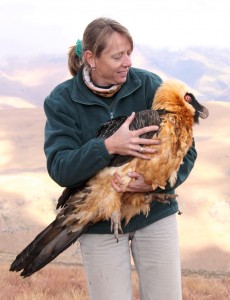
I have had the privilege of working with Sonja Krüger and observe her
dedication and drive to conserve the Bearded Vulture in southern Africa
since 2004. Working as an Ecologist with KZN Wildlife and as the
coordinator of the Bearded Vulture Task Force of the EWT’s Birds of Prey
Programme, Sonja has been able to successfully implement and adapt our
approaches to the conservation of the species in our region across its
entire range and involving stakeholders from a range of international,
national as well as provincial institutions and NGO’s while involving
land-owners and other communities in this initiative. Sonja’s dedication is
expressed in so many ways, but conducting monitoring in the
Maloti-Drakensberg in mid-winter, often on foot, and spending hours in a
variety of cramped hides waiting to capture birds for tracking purposes are
two examples thereof. The scope of work and advances made in conservation
action focused on Bearded Vultures in the region are further testament to
Sonja’s hard work in ensuring that these birds will remain the flagship
species associated with the Maloti-Drakensberg and resulted in Sonja being
awarded the Vulture Conservationist of the Year Award in 2007. She is
cuurently completing her PhD focused on this species with the university of
Cape Town.
André Botha, South Africa
1) What is known about the current status of the Bearded Vulture in Africa?
The isolated population in southern Africa has about 100 breeding pairs in the Maluti-Drakensberg mountains with a total population of between 300 and 350 individuals. Ethiopia is still believed to be the stronghold of the species in Africa although no recent estimates exist. Only a few pairs are left in Kenya, Uganda and Tanzania.
2) Has the population changed during the last decades?
Detailed research was done on the species in southern Africa in the 1980s. At the time the population was estimated at 200 breeding pairs. Many nest sites in peripheral areas have been abandoned and the breeding range has reduced in size. It is assumed that this is as a result of increased human disturbance at these sites, either infrastructural developments or increased population density and intensity of farming activities.
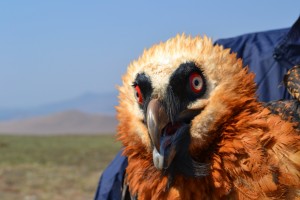
3) What is known about the genetic difference between the birds in southern and eastern Africa and those outside of Africa?
The population south of the Tropic of Cancer (Gypaetus barbatus meridionalis) is thought to be genetically distinct from that north of the Tropic of Cancer in Africa, Europe and Asia (G. barbatus barbatus). Godoy et al. (2004) on the other hand suggest that the global Bearded Vulture population could be treated as a single population since there is no significant difference in life history traits, morphology, habitat or behaviour. However, their assessment was based on only three samples from sub-Saharan Africa. Samples from southern Africa are currently being analysed to increase the sample size to substantiate the finding of Godoy et al. (2004). The results of these findings have implications on the future management of the population
4) What is the preferred habitat of the species?
The birds prefer mountainous terrainand escarpments where they nest in potholes on cliff faces at altitudes above 1800m and on average at 2800m. They forage over lowland areas, over open terrain where they can spot carcasses at a distance.
5) Is there competition with other raptors about food and nesting places?
Since the Bearded Vulture’s diet consists almost exclusively of bone (which is swallowed), there is no competition at feeding stations. They are famous for carrying bones to heights from which they drop them to break them into smaller pieces that can be swallowed with ease. Adults do require meat in the breeding season to feed the chicks. Corvids have been seen harassing Bearded Vultures at established feeding stations where small bone fragments and pieces of meat are placed out for the birds. These morsels appeal to most of the large raptors and the Beardeds tends to steer clear of a lot of scavenging activity.
Bearded Vultures are often found nesting close to Cape Vultures. The habitat preference and choice of nesting sites of Verreaux Eagles is similar to that of the Bearded Vulture and altercations between these two species occur frequently.
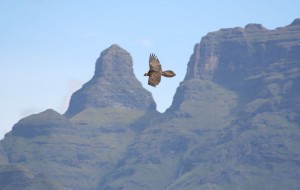
6) What is the main food for the Bearded Vulture? Is the Bearded Vulture dependent on Livestock?
Ideally the birds feed on the carcasses of small to medium sized mammals, although bones of larger animals can be broken into smaller pieces. A large part of the species’ range is open grassland where livestock (sheep, goats, cattle) are abundant in summer. In winter, the birds are more reliant on supplementary feeding at feeding stations. In protected areas they feed on wildlife carcasses/afterbirths, particularly when these are plentiful in summer during the lambing/calving season.
7) How important is the presence of large carnivores like lions or leopards as a provider of carrion for the Bearded Vulture?
Large carnivores are scarce throughout the range of the species, therefore these are not important providers of carrion. Bearded Vultures inhabit harsh environments where many animals succumb to the affects of adverse weather and accidental deaths in steep, hostile and inaccessible terrain. Land use change over the past few decades has resulted in large scale transformation of their habitat making supplementary feeding a necessary conservation management action.
8 ) Are Bearded Vultures affected by poisoning?
Poisoning is one of the primary causes of mortality. To date three out of 14 birds fitted with satellite tracking devices have been killed by poison. Bearded Vultures are often accidentally poisoned when feeding on poisoned bait meant for jackal. Since all vulture species are particularly sought after in the traditional medicine trade, the Bearded Vulture is not spared from deliberate poisoning, although they may be more difficult to target. Many herdsman still believe that the birds prey on lambs and deliberately shoot or poison them.
9) In Europe, Bearded Vultures are threatened by lead poisoning (by ingesting lead ammunition). How is the situation in Africa?
Conservation agencies in southern Africa are well aware of the lead threat and are making every effort to inform the public and hunting fraternity of this threat as well as changing the type of ammunition used, the method of culling and disposal of carcasses. Wild caught birds that have been tested for lead levels have not shown unusually high levels of lead. Limited hunting takes places within the range of the species.
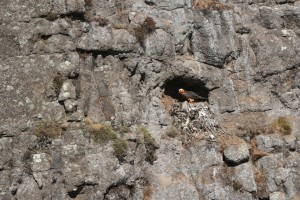
10) What other threats for the species do exist?
Collisions with energy structures such as powerlines and wind farms remain the next biggest threat to the species. Additional threats include habitat loss and food shortage as a result of land use change and improved animal husbandry. Human persecution and nest disturbance, are minor threats in Africa but the impacts of mountain climbing on nesting success still needs to be investigated. New threats to the species include their potential vulnerability to climate change and requires further investigation.
11) What is known about breeding success and the annual survival of Bearded Vultures?
The breeding success of the species within their core range is high and similar to that found in the 1980s (about 85%). However breeding success at peripheral sites is much lower with many of these sites having been abandoned over the past few decades.
There is limited recent information on the survival rate of the species. A marking programme has been initiated to provide more information on this and research is being done to determine the number of individuals that survive to the next age class. The average annual adult survival has been estimated at 95% and other age classes have a average survival rate of 11% . Longeivity is estimated at about 20 years in the wild.
12) What gaps in our knowledge about the Bearded Vulture do exist and where should research focus in the next years?
Research should focus on i) which environmental variables account for the abandonment of breeding territories, ii) whether there are age specific differences in the spatial and temporal use of home range that places the birds at risk, iii) whether the population has enough genetic variation and is genetically similar to other populations in sub-Saharan Africa, iv) what the primary factors affecting survival and breeding success of the population are, and v) what the future growth rate of the population is likely to be and vi) what the conservation interventions are that can effectively influence this trend.
13) What needs to be done to secure the future of the Bearded Vulture in Africa?
There is an urgent need to address the threats to the species in particular the threat of poisoning and ever increasing threat of land use changes and associated infrastructural developments (e.g. powerlines). Education and Awareness of the great public on the importance of the species and its role in the environmental is essential. Captive breeding for supplementation of the wild population must be considered but will only be implemented once the threats to the species have been adequately addressed.
14) Are there any conservation projects or research projects for the Bearded Vulture?
A Biodiversity management Plan is in preparation for the species which details the conservation objectives for the species and lists the operational goals required to address these. The gaps in our knowledge are currently being addressed through a research programme which aims to address the points listed in 12 above.
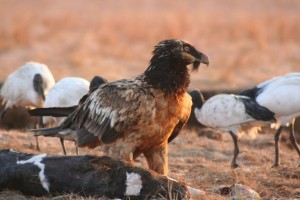
15) How can people help to protect the Bearded Vulture?
People can dispel the myths that these birds are predators and catch lambs, report sightings of marked birds, report the location of any known nest sites and encourage the use of alternate methods of predator control and alternate options f energy provision.
16) What was your most amazing experience with Bearded Vultures?
Over the past few years, I have had many amazing experiences with the birds. After a long days hike to a nest in the mountains, it is always rewarding to see the birds at the nest- even if you can’t see inside. Watching birds landing and feeding at close proximity is always special. I’ve had the privileged of handling a number of these birds and am always captivated by how large and majestic they are. But the most amazing experience must be sitting camouflaged in the grassland listening to the wind whistling in their wings as the circle a few meters above your head.

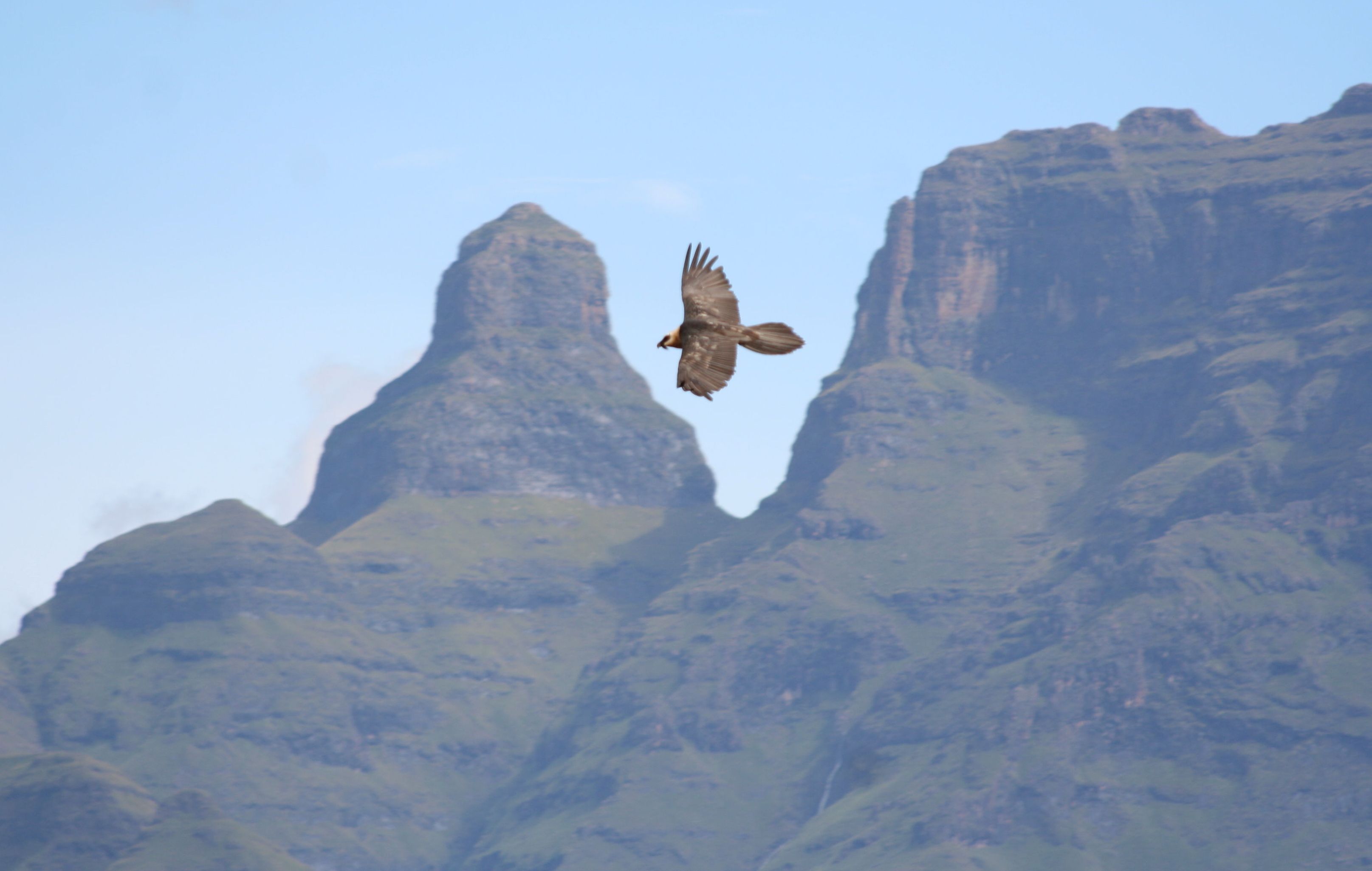
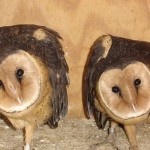
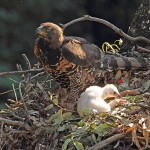

I am sub editor of Birdlife Harties newsletter and involved with our Cape vulture program on the Magalies. All raptors are wonderful and your effort most appreciated as well.